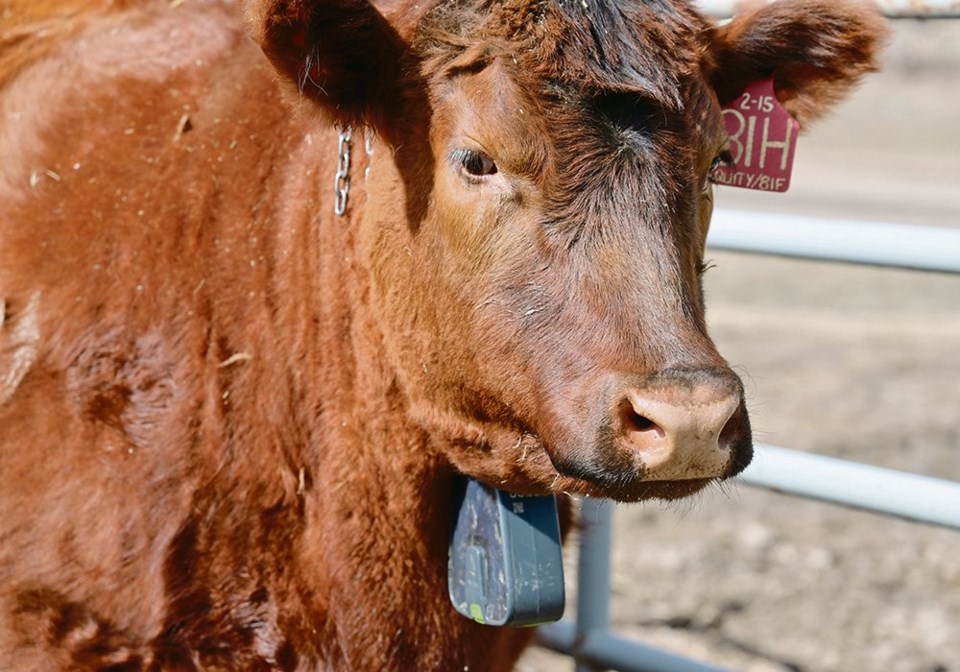OLDS, Alta. — The time, effort and money put into creating temporary livestock fencing is one of the main reasons farmers don’t rotational graze, despite its proven benefits.
But would more farmers rotational graze if setting the boundaries of a fence took two or three minutes and a click of a button from their cellphone, wondered Laio Silva Sobrinho, research associate with the Technology Access Centre for Livestock Production at Olds College.
This summer, Sobrinho plans to place 40 virtual fence collars on animals in an Olds College pasture and test the Norwegian company Nofence’s virtual electric fence technology in Canada for the first time.
“By having something like a virtual fence, you will take out that time and cost barrier out of the way. It will be much easier to have a rotational grazing system in place. You can do that from your computer. Instead of 500 head grazing you could have 1,000,” said Sobrinho.
“Electric fencing is a huge cost per mile. It is thousands of dollars depending on the setup. By having a virtual fence, you don’t have to have that in place, you don’t need any fence inside the perimeter.”
At the beginning of April, four virtual fence collars were placed on cattle in a corral at the college to see how the solar charging system worked and if the cattle were stressed with the large bell-shaped collar snugged around their necks. The battery charge of each collar can be monitored from the app and it showed an increase in battery strength after only a few days.
“It shows the collars will actually be able to run throughout the grazing season without us having to change the batteries.”
In mid-May, the animals will be put on pasture and the virtual fence test will begin. The plan is to put the collars on 40 cows and a GPS tag on their calves. Some collars may be placed on calves if there is a way to attach the collars to the growing animals.
When the animals get close to the virtual fence an audio cue alerts the animal that they are getting close to the fence. If the animals continue to stray closer to the fence, they will receive a shock.
“The audio is a song that lasts around 30 seconds. It is very simple. It seems like it works very well. It is not too loud and doesn’t get them excited.”
By looking at the app, Sobrinho will be able to see how many audio signals or shocks each animal received, if they turned away from the fence, how often they went near the virtual fence, or if they walked through the virtual fence. The outside perimeter will have a traditional wire fence, but the inside will be divided into multiple paddocks and rotational grazed with the virtual fence adjusted through a computer or cellphone.
The original Nofence virtual fencing system was designed in Norway for sheep and goats. The research in Olds this summer will look at how the technology works on cattle in Canadian field conditions. The research will test any internet connection troubles, solar battery charging and measure the grazing and financial benefits of rotational grazing.
“We want to know how many animals go out of the boundaries and the frequency and if they go out, what is the effect on the rotational grazing system we set up. One of the principles is we don’t want to graze more than 50 percent of the biomass available. We want to know if animals go out of the boundary if it affects that 50-50 rule.”
If the cow or a calf goes out of bounds and is safe, researchers will just monitor and not put the animal back inside the virtual fence. The level of stress of the animals wearing the collars will be tested by looking at cortisol levels in hair and fecal samples.
The virtual fencing experiments won’t end when the animals come off grass in the fall. The collars will be tested on animals swath grazing in the winter to see how well the solar-charged battery stays charged in Canadian winters.
At $550 a collar, it is a pricey fencing system and is likely too expensive for many prairie producers to adopt. Part of the research will compare the cost of the Nofence system and its rotational grazing benefits versus the costs of labour and equipment with a traditional rotational grazing system.
“Virtual fencing will only be accessible if producers can make more pasture profitability and increase stocking density or herd numbers. In our research plan, we also want to study the difference in labour requirements.”
Rotational grazing is highly intensive in management. It is the first reason producers give for not adopting the technology. If producers can eliminate those costs with a virtual fencing system and possibly receive carbon credits by rotationally grazing their animals, it may become an option, said Sobrinho.
“Producers who have thousands of acres and could get carbon credits if they have a rotational grazing system in place, it may be an option. They would be more likely to receive any carbon credits in the future.”
Sobrinho said he is also looking at other virtual fencing companies including E-shepherd collars from Australia, Halter from New Zealand and Vence from the United States. The Vence technology system is a rental system and costs producers $2 to $4 a month.




